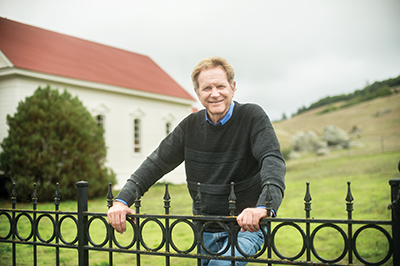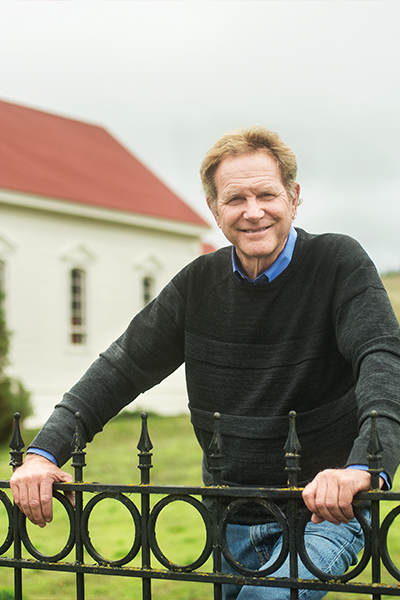 Photo by Tim Porter
Photo by Tim Porter
YOU’VE HEARD THE story: a builder is frustrated with county processes so he or she runs for office to change “the system.” Versions of that tale have been told for years. But it wasn’t why designer/ builder Steve Kinsey ran for the Marin Board of Supervisors in 1996. He just thought serving in government would be a rewarding experience and that he’d be good at it. Though he had never run for elective office, he’d been engaged in civic activities since moving to West Marin in 1978. Intrinsically optimistic and outgoing, Kinsey was a Little League coach, had worked to pass school and water bonds, and had appeared numerous times at supervisorial meetings. So he declared his candidacy. He won that first election as well as the next four before announcing in late 2015 that he’d be retiring after 20 years representing Marin County’s 4th District, which encompasses all of Corte Madera, most of West Marin and parts of Larkspur, San Quentin, Novato, San Rafael and Homestead Valley. In all, some 50,000 residents and about two-thirds of Marin’s landmass.
Over the years, Kinsey, now 64, has championed sustainable agriculture, watershed and salmon restoration, integrating various modes of transportation, and a government based on fiscal responsibility. He’s been on the California Coastal Commission for five years, the past three as its chairman, an assignment that has sent him up and down the state’s 1,100-mile coastline. His other involvements include the Marin Agriculture Land Trust (MALT), the Metropolitan Transportation Commission (MTC) and the Transportation Authority of Marin (TAM).
The West Marin community of Forest Knolls is where Kinsey and his wife make their home. In his off duty-hours he enjoys biking, hiking and camping.
On January 1, you will no longer be a county supervisor and will be even freer to speak your mind. What are your thoughts on the following?
Homelessness in Marin County
I think there are sites that could handle a multiservice center for the homeless. A portion of the Silveira property near where we had an honor farm in the past. Somewhere on St. Vincent’s would also work. Also, I’ve suggested that a small portion of the CanalWays, down by Target and Home Depot, is a possibility. And there are places near San Quentin State Prison, on the west side of Sir Francis Drake Boulevard, or by the Smith Ranch Road Park and Ride that are possibilities. So there are places.
The Sonoma-Marin Area Rail Transit (SMART)
SMART’s success will depend on its ability to make quick changes once they start operating. Bicycle parking is one recent example; impacts on cars and pedestrians on city streets is another one. So it will be successful if they have an adaptive and responsive attitude once they start operating. And, they will have to come back to the electorate for more money to be able to run that program effectively over the next 20 years and beyond.
Ranching in Point Reyes
That environmental lawsuit is going to take a tedious bureaucratic journey that will last at least five years, maybe 10, depending on the litigation. Ultimately, ranching will continue in the park.
The Seminary property in South Marin
This will be decided in a few years and then it will be litigated and you won’t see any change there for over a decade. The Branson School will be there only if they are very patient, but I don’t think so. I think it will take them too long to get a decision as a school; it will cost too much money.
The Martha property near Tiburon
These 100- or-so scenic acres will determine if Marin has enormous philanthropic pull — or not. I think that ultimately it will not be developed; rather, it will be the highest-priced open space that has ever been acquired in California.
George Lucas’ now-withdrawn film studio project at Grady Ranch
I’ll be the number one cheerleader for that project if he decides to put the oar in the water. Although he’s talked about it, George hasn’t formally applied for it; he’s been distracted by where to put that damn museum. So there has been no movement on it over the past year. But I think it’s certainly a workable concept and a great gift he’s offering to Marin County.
Developing the Silveira/St. Vincent’s site
Nothing will happen until the community comes to realize that portions of St. Vincent’s could be developed and provide real access to SMART, all without changing the Silveira Ranch. Until then, it will languish; it’s a piece of Marin’s 50-year future, not our 10-year future.
A permanent farmers’ market at the Civic Center
It will happen. But they should start by getting the covered canopies and a few of the amenities done and then build the market hall, rather than trying to do it all at once. It’s a big chunk to raise $24 million. Better to raise $5 million today and show what they can do and raise the excitement. It’s an ideal location and the concept epitomizes Marin County.
Which are your proudest accomplishments after 20 years as a Marin supervisor?
Things that stand out for me are the capital projects we completed. An example would be the Emergency Operations Center, or EOC. What we did was buy the Marin Commons building south of Lucas Valley Road near Highway 101 and turn it into a seismically sound facility that can continue to operate after Marin is hit by a big earthquake. Our previous emergency center would have collapsed in such a disaster. This new one is set up so all communities and public agencies can work out of one safe place in the event of a major fire, flood or earthquake. I chaired a committee to rectify that situation and my mantra, summarizing something I felt was attainable, was “a new EOC by 2003.” Well, our new EOC opened in 2013, a full decade after my “attainable” goal, and that speaks to the frustrations one faces as a passionate and dedicated elected official. By the way, our new EOC cost $85 million.
I’m also excited to have helped create primary care health clinics in the Canal, Marin City, Bolinas and Novato. And of course, I think anyone who ever drove on Sir Francis Drake through Sam Taylor Park will recognize the amazing road upgrade. That took almost a decade to achieve.
On the other end of the spectrum, and I’m not kidding here, an accomplishment I’m proud of is the three-foot concrete traffic median in the town of Inverness that I lobbied for in 2002. It went in rather quickly and ever since then the Inverness Garden Club has maintained the median’s plantings; it has slowed traffic and added charm to the town. That’s a little gem I was able to pull off. Here’s another one: For over a year I tried to get two effective bus stops in Stinson Beach. I brought Marin Transit directors out there and somehow they just couldn’t get it done. So on a sunny afternoon, a few locals and I got together and dug the holes, set the two steel poles, poured the concrete in their bases and cleared away the brush. Now there are two bus stops in Stinson Beach that somehow managed to beat the bureaucracy.
When you look back over 20 years, what do you consider your greatest frustrations?
It’s the time and difficulty in decision-making. For the past 40 years, hard-core conservationists and environmental activists have controlled politics in Marin. And that was a good thing. What I like to say is: there was a land use war. We battled about building out our coast as Southern California did; about having parks or allowing sprawl; about building a freeway to the Point Reyes lighthouse. So it was a war — and we won the war. The film Rebels With a Cause really captures that spirit. But, we won the war, yet it seems that we have never sent the soldiers home. So now the war has converted to where someone in Lucas Valley Estates wants to move a chimney three feet and the result is a 45-page document that went through the planning process and ultimately came before the board of supervisors for a vote — a vote to move a chimney three feet. And I finally exploded and brought reality to the process. So looking back, another thing I’m proud of is that I never had the Sierra Club’s endorsement, and that I’ve resisted the idea we had to buckle to environmental extremes — while I’ve also been committed to a more sustainable future. What I’m saying is that for a county with supposedly liberal values, we actually don’t reflect them in our process of decision-making.
The Lucas affordable housing project was an enormous example of that. We should have been rolling out the carpet because his projects are so well designed. Instead, we made a big fuss and it was summarily withdrawn. Another example is the BCDC, the Bay Conservation and Development Commission, which wants literally to know what kind of shadow will be cast on the water by a suicide prevention barrier on the Golden Gate Bridge. It all represents a massive loss of common sense. Fortunately, laws can change and someday, someone with common sense will say differently. Anyway, I hope so.
As a Marin supervisor, what did you see as your darkest hours?
Probably it was having fellow supervisor Charles McGlashan disappear from the earth so unexpectedly when he died of heart failure in 2011; he was just 49. Then watching the decline and death of fellow supervisor Hal Brown only a year later. Then sitting for months as a board of only three — that was very difficult; nothing gets darker than that.
Do you have concerns about government in general?
I do, and it applies to all politics in America, not just the regional level. Once I decided to retire, I went to probably eight highly qualified, exceptional leader-type individuals who could immediately handle this job, some with different backgrounds than myself, but ones who definitely had the leadership skills this job entails. And not one of them wanted to touch the job. I think that politics has gotten very raw and personal and many people aren’t up to having their name smacked around on a daily basis. Also, many people think that in the Bay Area, $150,000 a year barely covers what you need to live on. And when you track it to the 60-plus hours a week of engagement, they can’t reconcile it. So that’s a definite challenge for a democratic government. On the other hand, people often rise to the occasion; I had no elective experience when I came on the board and now, 20 years later, I’m quite proud of what’s been accomplished.
Looking ahead: what are you going to do?
Once I leave office, I’ve committed to camping my way, with my partner, Jean, down to Baja and back over a six-week period. I’ll use it as a chance to relax, to be in a beautiful natural setting, to think more broadly, and to simply explore. Eventually, what I want to do is be involved as a consultant at the local or regional level in strengthening community, either in the field of transportation or in working to achieve equality in various aspects of contemporary life.


